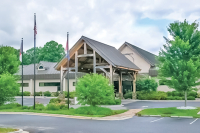Lasting damage: Recreation impacts from Fred could linger for years
 Log jams like this one on the upper Davidson River in the Pisgah National Forest could burst at any time, creating danger downstream. USFS photo
Log jams like this one on the upper Davidson River in the Pisgah National Forest could burst at any time, creating danger downstream. USFS photo
A week before Tropical Storm Fred unleashed historically high floodwaters on Western North Carolina, Greg Philipp was in Washington fighting the wildfires now enveloping the bone-dry American West. Now, Philipp is the U.S. Forest Service incident commander for the aftermath of heavy rainfall that will impact favorite recreation sites in the Pisgah National Forest for years to come.
“There’s places where the entire character of the place may be different,” he said.
While other areas of the forest also saw significant damage, the biggest impacts occurred on the Davidson River corridor and the Pisgah Forest area from the Blue Ridge Parkway down to the forest entrance, as well as within the Big Ivy, Stony Fork and Coleman Boundary areas of the Appalachian Ranger District.
On Saturday, Aug. 28, formal closure orders were signed for a long list of roads and recreation sites in those areas, including Looking Glass Falls, Sliding Rock Recreation Area, the Pisgah Center for Wildlife Education, Setzer Fish Hatchery and more.
“We’ve had some major damage to our facilities, like at Sliding Rock, for example, one of the favorites for people to come to,” he said. “Trail bridges are washed away in some places and need to be completely replaced in others. Roads that are important to bear hunters and horseback riders and backpackers are inaccessible.”
There are more than 140 bridges in the Pisgah and Nantahala national forests, and a bridge engineer will have to perform assessments on each one to see if they’re still safe to use.
Related Items
“There’s places where there used to be culverts that there’s no sign of it,” he said. “Roads are cut in half. We’ve had access to private residences completely severed.”
The storm downed a power line going up Davidson River Road, with power poles in the creek and the road blown out so that the power company couldn’t get vehicles out to reset the poles, said Philipp.
In press releases and Facebook posts, the Forest Service is also reminding the public about lingering danger from Fred — log jams in the rivers that could break lose at any time and underwater debris increasing the risk of returning to favorite swimming holes. So far, the Forest Service has found a dozen log jams on the popular tubing route between Coontree Picnic Area and Sycamore Flats Picnic Area, which is currently closed, and entire river channels have changed course following Fred.

Skinny Dip Falls is unrecognizable following Fred (above) compared to the view before the storm (below). USFS photos

Landslides and debris piles also increase the danger for outdoor recreation. It might be tempting to go and take a look at the damage, but for now, the best thing to do is to just stay away, said Philipp. There could be dangers that Forest Service crews have not yet discovered, and any accident resulting from exploration of damaged areas could result in a 911 call to rescue crews who are already stretched thin with flood recovery efforts.
“If you see storm damage, whether it be small landslides or log jams, just stay away,” he said. “Don’t go around temporary barriers or gates, because there may be cracks in the roads we’re unaware of or haven’t gotten to yet.”
Philipp fully expects that the fallout from Fred will have visible impacts for years to come. He likens the situation to the one that occurred on the Croatan National Forest in 2018 after Hurricane Florence passed through. Some of those damages still aren’t repaired.
“I wouldn’t be surprised if some of these fixes take in the neighborhood of two to three years to get all the way through,” he said of Fred.
As an added complication, more than a third of the people who the National Forests in North Carolina would normally tap into to work on recovery are currently out west, responding to a raging wildfire season. Additionally, the local staff who are working to roll out projects associated with the Great American Outdoors Act are the same ones who will be instrumental in the storm recovery — moving ahead with one of those projects will mean slowing down on the other.
By far, the Pisgah National Forest was the most heavily impacted piece of public land following Fred. While the section of the Blue Ridge Parkway between N.C. 215 and U.S. 276 was closed for several days following the storm, it’s now reopened, and all associated damage was small enough for Parkway staff to clean up in-house.
That said, the strip of land managed by the Blue Ridge Parkway is quite narrow along most of the road’s length, so some sites accessed from the Parkway but managed by the Forest Service did see significant impacts, including Skinny Dip Falls, whose bridge has been swept away with the water’s path completely changed from what it used to be. The area is not closed, but the Forest Service considers access to it unsafe and is discouraging visitors from going there.
The only Blue Ridge Parkway facility that remains closed following Fred is Price Lake , which is located near Blowing Rock. The storm damaged the gates on the dam that controls the water level, and the lake is now empty. Planning and executing repairs will take time.
Panthertown Valley , in the Nantahala National Forest near Cashiers, also saw extremely heavy rain and significant impacts, with a full trail assessment underway. Visitors should be cautious on trails and watch out for high water levels and unstable soil.

Water rushes through the now-closed Sliding Rock Recreation Area during Tropical Storm Fred.
Even as crews begin to work toward recovery, Philipps is keeping an eye on the weather radar, saying in an interview last week that he has “big concerns over rains to come in the future.”
As of press time, rains from Hurricane Ida — now downgraded to a tropical depression — are falling on Western North Carolina, with some areas predicted to receive up to 6 inches of rain and even larger amounts possible in isolated areas.
“An inch of rain on top of what we’ve already had could move some of this damage into places we don’t want it, and if people are there, it could have a bad outcome,” Philipp said.
One bright spot, though, is the fact that infrastructure projects focused on climate resilience fared extremely well through the record-breaking rains. In recent years the Forest Service has completed various projects with partners such as Trout Unlimited to improve passageways for aquatic organisms, and “across the board,” those were not damaged in the flood, Philipp said.
“Water is to the east as fire is to the west,” said Philipp. “It’s just as damaging and devastating when we have these storms. We’re trying to celebrate those successes we’ve had with some infrastructure that will stand up to the storm.”
Storm causes forest closures
Formal closure orders have been signed for multiple areas in the Appalachian and Pisgah Ranger Districts of the Pisgah National Forest. Use of these areas is prohibited until further notice.
In the Pisgah Ranger District, the following closures are in effect:
• Entry of any kind is prohibited at: Looking Glass Falls Stairs, Lower Observation Deck and Pool; Sliding Rock Recreation Area; Setzer Fish Hatchery and Wildlife Education Center; Wildlife Education Center Parking Lot and the first .01 miles of FSR 475C (Horse Cove Road); Wolf Ford Horse Camp; and Davidson River Road from Cove Creek to Gloucester Gap (FSR 475)
• Vehicles are prohibited at: Sycamore Flats Recreation Area, north end of the Art Loeb Trail and Little East Fork Trailhead at Daniel Boone Boy Scout Camp; and Cove Creek Group Camps (upper and lower).
• The following roads are closed to vehicles, cyclists and equestrians: Davidson River Road from Balsam Grove to Gloucester Gap (FSR 475); Courthouse Creek Road (FSR 140); and Pilot Mountain Road (FSR 229).
In the Appalachian Ranger District, the following roads are closed to all uses, including camping, with hikers, bikers and equestrians allowed on the closed roads only when using an open trail that intersects with a closed road: Stoney Fork Road (FSR 63); Big Ivy Road, Coleman Boundary (FSR 74); and South Toe Road beyond Black Mountain Campground, which is open, (FSR 472).
Other areas are not closed, but may not be safe for normal recreation use. Log jams and submerged debris make swimming, tubing and boating on the Pisgah Ranger District especially, much more dangerous than it was before Tropical Storm Fred. A dozen log jams found in the popular tubing route on the Davidson River from Coontree Picnic Area and Sycamore Flats Picnic Area are one such example. Visitors should refrain from water recreation in the area and avoid any area with visible landslides or other storm damage.
For updated closure information, visit www.fs.usda.gov/alerts/nfsnc/alerts-notices . Direct questions to the Appalachian Ranger District Office at This email address is being protected from spambots. You need JavaScript enabled to view it. or 828.689.9694, or to the Pisgah Ranger District Office at This email address is being protected from spambots. You need JavaScript enabled to view it. or 828.877.3265.









